A Holistic Approach to Study Groundwater-Surface Water Modifications Induced by Strong Earthquakes: The Case of Campiano Catchment (Central Italy)
Abstract
:1. Introduction
2. Geo-Structural Setting of the Area
3. Hydrogeological Setting
4. Materials and Methods
4.1. Analysis of Stream Hydrograph
4.2. Tracer Tests
- i.
- Label the water movement from the injection point to the main springs of the area;
- ii.
- Determine the interaction between the tectonic lineaments (faults) and the groundwater flow direction, and their possible modification due to the earthquakes;
- iii.
- Assess the groundwater flow velocities (mean and maximum) by calculating the mean tracer transit time and the first peak arrival. To achieve this, after a denoising procedure on the tracer arrival signal recorded by the fluorometric probe, a quantitative tracer analysis was performed by Qtracer2 ver. 2 free software for the karst and fractured aquifers’ tracer tests interpretation [59].
4.3. Hydrochemical and Isotopic Analyses
4.4. Hydrogeological Map and Cross-Sections
5. Results and Discussion
5.1. Discharge Modification Due to the Seismic Sequence
5.2. Tracer Hydrology Evidence
5.3. Hydrochemical and Isotope Hydrology Approaches
5.4. Hydrogeological Conceptual Model
6. Conclusions
Author Contributions
Funding
Institutional Review Board Statement
Informed Consent Statement
Data Availability Statement
Acknowledgments
Conflicts of Interest
References
- Hauksson, E. Radon Content of Groundwater as an Earthquake Precursor: Evaluation of Worldwide Data and Physical Basis. J. Geophys. Res. Solid Earth 1981, 86, 9397–9410. [Google Scholar] [CrossRef] [Green Version]
- King, C.-Y.; Zhang, W.; Zhang, Z. Earthquake-Induced Groundwater and Gas Changes. Pure Appl. Geophys. 2006, 163, 633–645. [Google Scholar] [CrossRef]
- Ingebritsen, S.E.; Manga, M. Hydrogeochemical Precursors. Nat. Geosci. 2014, 7, 697–698. [Google Scholar] [CrossRef]
- Ingebritsen, S.E.; Manga, M. Earthquake Hydrogeology. Water Resour. Res. 2019, 55, 5212–5216. [Google Scholar] [CrossRef] [Green Version]
- Elkhoury, J.E.; Brodsky, E.E.; Agnew, D.C. Seismic Waves Increase Permeability. Nature 2006, 441, 1135–1138. [Google Scholar] [CrossRef]
- Bense, V.F.; Gleeson, T.; Loveless, S.E.; Bour, O.; Scibek, J. Fault Zone Hydrogeology. Earth-Sci. Rev. 2013, 127, 171–192. [Google Scholar] [CrossRef]
- Sibson, R.H. Fluid Flow Accompanying Faulting: Field Evidence and Models. Earthq. Predict. Int. Rev. 1981, 4, 593–603. [Google Scholar]
- Manga, M. Origin of Postseismic Streamflow Changes Inferred from Baseflow Recession and Magnitude-Distance Relations. Geophys. Res. Lett. 2001, 28, 2133–2136. [Google Scholar] [CrossRef] [Green Version]
- Mohr, C.H.; Manga, M.; Wang, C.-Y.; Korup, O. Regional Changes in Streamflow after a Megathrust Earthquake. Earth Planet. Sci. Lett. 2017, 458, 418–428. [Google Scholar] [CrossRef] [Green Version]
- Petitta, M.; Mastrorillo, L.; Preziosi, E.; Banzato, F.; Barberio, M.D.; Billi, A.; Cambi, C.; De Luca, G.; Di Carlo, G.; Di Curzio, D.; et al. Water-Table and Discharge Changes Associated with the 2016–2017 Seismic Sequence in Central Italy: Hydrogeological Data and a Conceptual Model for Fractured Carbonate Aquifers. Hydrogeol. J. 2018, 26, 1009–1026. [Google Scholar] [CrossRef] [Green Version]
- Wang, C.-Y.; Manga, M. New Streams and Springs after the 2014 Mw6.0 South Napa Earthquake. Nat. Commun. 2015, 6, 7597. [Google Scholar] [CrossRef] [PubMed] [Green Version]
- Valigi, D.; Fronzi, D.; Cambi, C.; Beddini, G.; Cardellini, C.; Checcucci, R.; Mastrorillo, L.; Mirabella, F.; Tazioli, A. Earthquake-Induced Spring Discharge Modifications: The Pescara Di Arquata Spring Reaction to the August–October 2016 Central Italy Earthquakes. Water 2020, 12, 767. [Google Scholar] [CrossRef] [Green Version]
- Fronzi, D.; Mirabella, F.; Cardellini, C.; Caliro, S.; Palpacelli, S.; Cambi, C.; Valigi, D.; Tazioli, A. The Role of Faults in Groundwater Circulation before and after Seismic Events: Insights from Tracers, Water Isotopes and Geochemistry. Water 2021, 13, 1499. [Google Scholar] [CrossRef]
- Mastrorillo, L.; Saroli, M.; Viaroli, S.; Banzato, F.; Valigi, D.; Petitta, M. Sustained Post-seismic Effects on Groundwater Flow in Fractured Carbonate Aquifers in Central Italy. Hydrol. Process. 2020, 34, 1167–1181. [Google Scholar] [CrossRef] [Green Version]
- Valigi, D.; Mastrorillo, L.; Cardellini, C.; Checcucci, R.; Di Matteo, L.; Frondini, F.; Mirabella, F.; Viaroli, S.; Vispi, I. Springs Discharge Variations Induced by Strong Earthquakes: The Mw 6.5 Norcia Event (Italy, October 30th 2016). Rend. Online Soc. Geol. Ital. 2019, 47, 141–146. [Google Scholar] [CrossRef]
- Howard, J.; Merrifield, M. Mapping Groundwater Dependent Ecosystems in California. PLoS ONE 2010, 5, e11249. [Google Scholar] [CrossRef] [Green Version]
- Lizundia, B.; Shrestha, S.N.; Bevington, J.; Davidson, R.; Jaiswal, K.; Jimee, G.K.; Kaushik, H.; Kumar, H.; Kupec, J.; Mitrani-Reiser, J. M7. 8 Gorkha, Nepal Earthquake on April 25, 2015 and Its Aftershocks. In EERI Earthquake Reconnaissance Team Report; Earthquake Engineering Research Institute: Oakland, CA, USA, 2016; pp. 1–185. [Google Scholar]
- Calamita, F.; Deiana, G. Evoluzione Strutturale Neogenico-Quaternaria Dell’Appennino Umbro-Marchigiano. In Proceedings of the Studi Geologici Camerti, Congresso Società Geologica Italiana 73°, Roma, Italy, 30 September–4 October 1986; pp. 91–98. [Google Scholar]
- Brozzetti, F.; Lavecchia, G. Seismicity and Related Extensional Stress Field: The Case of the Norcia Seismic Zone (Central Italy). Ann. Tecton. 1994, 8, 36–57. [Google Scholar]
- Porreca, M.; Minelli, G.; Ercoli, M.; Brobia, A.; Mancinelli, P.; Cruciani, F.; Giorgetti, C.; Carboni, F.; Mirabella, F.; Cavinato, G. Seismic Reflection Profiles and Subsurface Geology of the Area Interested by the 2016–2017 Earthquake Sequence (Central Italy). Tectonics 2018, 37, 1116–1137. [Google Scholar] [CrossRef]
- Viaroli, S.; Mirabella, F.; Mastrorillo, L.; Angelini, S.; Valigi, D. Fractured Carbonate Aquifers of Sibillini Mts.(Central Italy). J. Maps 2021, 17, 140–149. [Google Scholar] [CrossRef]
- Boccaletti, M.; Calamita, F.; Viandante, M.G. La Neo-Catena Litosferica Appenninica Nata a Partire Dal Pliocene Inferiore Come Espressione Della Convergenza Africa-Europa. Boll. Della Soc. Geol. Ital. 2005, 124, 87–105. [Google Scholar]
- Mazzoli, S.; Pierantoni, P.P.; Borraccini, F.; Paltrinieri, W.; Deiana, G. Geometry, Segmentation Pattern and Displacement Variations along a Major Apennine Thrust Zone, Central Italy. J. Struct. Geol. 2005, 27, 1940–1953. [Google Scholar] [CrossRef]
- Centamore, E.; Rossi, D. Neogene-Quaternary Tectonics and Sedimentation in the Central Apennines. Boll. Della Soc. Geol. Ital. 2009, 128, 73–88. [Google Scholar]
- Di Domenica, A.; Turtù, A.; Satolli, S.; Calamita, F. Relationships between Thrusts and Normal Faults in Curved Belts: New Insight in the Inversion Tectonics of the Central-Northern Apennines (Italy). J. Struct. Geol. 2012, 42, 104–117. [Google Scholar] [CrossRef]
- Scisciani, V.; Patruno, S.; Tavarnelli, E.; Calamita, F.; Pace, P.; Iacopini, D. Multi-Phase Reactivations and Inversions of Paleozoic–Mesozoic Extensional Basins during the Wilson Cycle: Case Studies from the North Sea (UK) and the Northern Apennines (Italy). Geol. Soc. Lond. Spec. Publ. 2019, 470, 205–243. [Google Scholar] [CrossRef]
- Chiaraluce, L.; Di Stefano, R.; Tinti, E.; Scognamiglio, L.; Michele, M.; Casarotti, E.; Cattaneo, M.; De Gori, P.; Chiarabba, C.; Monachesi, G. The 2016 Central Italy Seismic Sequence: A First Look at the Mainshocks, Aftershocks, and Source Models. Seismol. Res. Lett. 2017, 88, 757–771. [Google Scholar] [CrossRef]
- Civico, R.; Pucci, S.; Villani, F.; Pizzimenti, L.; De Martini, P.M.; Nappi, R.; Group, O.E.W. Surface Ruptures Following the 30 October 2016 M w 6.5 Norcia Earthquake, Central Italy. J. Maps 2018, 14, 151–160. [Google Scholar] [CrossRef] [Green Version]
- Brozzetti, F.; Boncio, P.; Cirillo, D.; Ferrarini, F.; De Nardis, R.; Testa, A.; Liberi, F.; Lavecchia, G. High-resolution Field Mapping and Analysis of the August–October 2016 Coseismic Surface Faulting (Central Italy Earthquakes): Slip Distribution, Parameterization, and Comparison with Global Earthquakes. Tectonics 2019, 38, 417–439. [Google Scholar] [CrossRef] [Green Version]
- Pierantoni, P.; Deiana, G.; Galdenzi, S. Stratigraphic and Structural Features of the Sibillini Mountains (Umbria-Marche Apennines, Italy). Ital. J. Geosci. 2013, 132, 497–520. [Google Scholar] [CrossRef]
- Principi, P. Idrologia Sotterranea Della Pianura Di Norcia. Boll. Soc. Geol. Ital. 1911, 30, 849–862. [Google Scholar]
- Lippi Boncambi, C. Idrologia Sotterranea Dell’Altipiano Di Castelluccio; Annali Istituto di Mineralogia e Geologia dell’Università degli Studi di Perugia: Perugia, Italy, 1969; pp. 104–118. [Google Scholar]
- Lippi Boncambi, C. Indagini Idrogeologiche Sull’altipiano Di Castelluccio Di Norcia. In Proceedings of the Atti del IX Congresso Nazionale di Speleologia, Trieste, Italy, 20 September–2 October 1963. [Google Scholar]
- Cencetti, C.; Dragoni, W.; Nejad Massoum, M. Contributo Alle Conoscenze Delle Caratteristiche Idrogeologiche Del Fiume Nera (Appennino Centro-Settentrionale). Geol. Appl. E Idrogeol. 1989, 24, 191–210. [Google Scholar]
- Boni, C.; Falcone, M.; Giaquinto, S.; Martini, E.; Zoppis, L.; Marchetti, G.; Martinelli, A. Risorse Idriche Sotterranee Dei Massicci Carbonatici Umbri. Acque Sotter. Umbria 1991, 413, 49–64. [Google Scholar]
- Nanni, T.; Vivalda, P. Caratteri Idrogeologici Delle Sorgenti Carbonatiche Dell’Appennino Marchigiano. Conv Naz Su Ri-Cerche E Prot. Delle Risorse Idriche Sotter. Delle Aree Montuose 1992, 1, 269–331. [Google Scholar]
- Boni, C.; Preziosi, E. Le Sorgenti Lineari Nell’alto Bacino Del Fiume Nera (Appennino Umbro–Marchigiano Italia Centrale). In Proceedings of the Atti dell’International Meeting for Young Researchers in Applied Geology, Peveragno, Italy, 11–13 October 1994; pp. 31–35. [Google Scholar]
- Mastrorillo, L.; Baldoni, T.; Banato, F.; Boscherini, A.; Cascone, D.; Checcucci, R.; Petitta, M.; Boni, C. Analisi Idrogeologica Quantitativa Del Dominio Carbonatico Umbro. Ital. J. Eng. Geol. Environ. 2009, 1, 137–155. [Google Scholar]
- Mastrorillo, L. Contributo Alla Valutazione Delle Risorse Idriche Sotterranee Dell’Appennino Carbonatico Marchigiano. Quad. Geol. Appl. 1996, 1, 25–35. [Google Scholar]
- Mastrorillo, L. Elementi Strutturali e Caratteristiche Idrogeologiche Della Dorsale Carbonatica Umbro-Marchigiana Interna. Mem. Della Soc. Geol. Ital. 2001, 56, 219–226. [Google Scholar]
- Boscherini, A.; Checcucci, R.; Natale, G.; Natali, N. Carta Idrogeologica Della Regione Umbria a Scala 1: 100.000. G. Geol. Appl. 2005, 2, 399–404. [Google Scholar]
- Tarragoni, C. Determinazione Della “Quota Isotopica” Del Bacino Di Alimentazione Delle Principali Sorgenti Dell’alta Valnerina. Geol. Romana 2006, 39, 55–62. [Google Scholar]
- Boni, C.; Ruisi, M. Le Grandi Sorgenti Che Alimentano Il Corso Del Fiume Nera-Velino: Una Importante Risorsa Strategica Nell’economia Dell’Italia Centrale. Atti Dei Convegni Lincei-Accad. Naz. Dei Lincei 2008, 232, 141. [Google Scholar]
- Boni, C.; Petitta, M. Redazione Informatizzata Della Cartografia Idrogeologica Tematica Del Territorio Della Regione Umbria. Tech. Note 2008, 2008, 131. [Google Scholar]
- Boni, C.F.; Baldoni, T.; Banzato, F.; Cascone, D.; Petitta, M. Studio Idrogeologico per l’identificazione, La Caratterizzazione e La Gestione Degli Acquiferi Del Parco Nazionale Dei Monti Sibillini. Ital. J. Eng. Geol. Env. 2010, 2, 21–39. [Google Scholar]
- Martinis, B. Alcune Informazioni Sulla Formazione Evaporitica Del Triassico Superiore Nell’Italia Centrale Meridionale. Mem. Soc. Geol. Ital. 1964, 4, 649–678. [Google Scholar]
- Petitta, M. Integrazione Della Base Conoscitiva per La Gestione Della Risorsa Idrica Sotterranea Del Parco Nazionale Dei Monti Sibillini; Technical Report for Internal Use; Parco Nazionale dei Monti Sibillini: Visso, Italy, 2011; p. 101. [Google Scholar]
- Valigi, D.; Cardellini, C.; Mirabella, F.; Tazioli, A.; Petitta, M.; Caliro, S.; Cambi, C.; Banzato, F.; Beddini, G.; Fronzi, D.; et al. Contributo Alla Ricerca Caratterizzazione Dei Sistemi Idrogeologici Del Territorio Umbro Influenzato Dagli Eventi Sismici Del 26–30 Ottobre 2016 e Valutazione Degli Effetti Del Sisma Sull’approvvigionamento Idrico 2019. 2019, pp. 1–212. Available online: https://www.regione.umbria.it/-/caratterizzazione-dei-sistemi-idrogeologici-del-territorio-umbro-influenzato-dagli-eventi-sismici-2016-e-valutazione-degli-effetti-del-sisma-su-approv (accessed on 29 April 2022).
- Nanni, T.; Vivalda, P.M.; Palpacelli, S.; Marcellini, M.; Tazioli, A. Groundwater Circulation and Earthquake-Related Changes in Hydrogeological Karst Environments: A Case Study of the Sibillini Mountains (Central Italy) Involving Artificial Tracers. Hydrogeol. J. 2020, 28, 2409–2428. [Google Scholar] [CrossRef]
- Maillet, E. Essais d’Hydraulique Souterraine et Fluviale [Underground and River Hydrology]; Hermann: Paris, France, 1905; p. 218. [Google Scholar]
- Fronzi, D.; Di Curzio, D.; Rusi, S.; Valigi, D.; Tazioli, A. Comparison between Periodic Tracer Tests and Time-Series Analysis to Assess Mid- and Long-Term Recharge Model Changes Due to Multiple Strong Seismic Events in Carbonate Aquifers. Water 2020, 12, 3073. [Google Scholar] [CrossRef]
- Di Matteo, L.; Dragoni, W.; Azzaro, S.; Pauselli, C.; Porreca, M.; Bellina, G.; Cardaci, W. Effects of Earthquakes on the Discharge of Groundwater Systems: The Case of the 2016 Seismic Sequence in the Central Apennines, Italy. J. Hydrol. 2020, 583, 124509. [Google Scholar] [CrossRef]
- Di Matteo, L.; Capoccioni, A.; Porreca, M.; Pauselli, C. Groundwater-Surface Water Interaction in the Nera River Basin (Central Italy): New Insights after the 2016 Seismic Sequence. Hydrology 2021, 8, 97. [Google Scholar] [CrossRef]
- Biella, G.; Lavecchia, G.; Lozey, A.; Pialli, G.; Scarascia, S. Primi Risultati Di Un’indagine Geofisica e Interpretazione Geologica Del Piano Di S. Scolastica e Del Piano Grande (Norcia, PG). In Proceedings of the Convegno Annuale G.N.G.T.S.; Atti 1° Convegno Gruppo Naz. Geof. Terra Solida, Roma, Italy. 1981, pp. 293–308. Available online: https://ricerca.unich.it/handle/11564/505514?mode=full.23#.XyDyzecRVPZ (accessed on 29 April 2022).
- Lippi Boncambi, C. Soil Observations on the Sibillini Mountains, in Particular on the Peaty Soils of the Castelluccio Di Norcia Plain. Boll. Soc. Geol. Ital. 1950, 69, 26–37. [Google Scholar]
- Villani, F.; Maraio, S.; Bruno, P.P.; Improta, L.; Wood, K.; Pucci, S.; Civico, R.; Sapia, V.; De Martini, P.M.; Brunori, C.A. High-Resolution Seismic Profiling in the Hanging Wall of the Southern Fault Section Ruptured During the 2016 Mw 6.5 Central Italy Earthquake. Tectonics 2021, 40, e2021TC006786. [Google Scholar] [CrossRef]
- Na, G.M. Geomineraria Nazionale Ligniti e Torbe Dell’Italia Centrale; Geo Mineraria Nazionale: Torino, Italy, 1962. [Google Scholar]
- Coltorti, M.; Farabollini, P. Quaternary Evolution of the Castelluccio Di Norcia Basin (Umbro-Marchean Apennines, Central Italy). Il Quat. 1995, 8, 149–166. [Google Scholar]
- Field, M.S. The QTRACER2 Program for Tracer-Breakthrough Curve Analysis for Tracer Tests in Karstic Aquifers and Other Hydrologic Systems; National Center for Environmental Assessment—Washington Office: Washington, DC, USA, 2002.
- Console, F.; Motti, A.; Pantaloni, M. L’intermittenza Delle Sorgenti Del Torbidone Nella Piana Di Norcia: Analisi Delle Fonti Storiche a Partire Dal XIV Secolo. Rend Online Soc. Geol. Ital. 2017, 43, 36–56. [Google Scholar] [CrossRef]
- Civita, M.V.; Fiorucci, A. The Recharge-Discharge Process of the Peschiera Spring System (Central Italy). Aqua. Mundi. 2010, 1, 161–178. [Google Scholar]
- Giacopetti, M.; Materazzi, M.; Pambianchi, G.; Posavec, K. Analysis of Mountain Springs Discharge Time Series in the Tennacola Stream Catchment (Central Apennine, Italy). Environ. Earth Sci. 2017, 76, 20. [Google Scholar] [CrossRef]
- Tamburini, A.; Menichetti, M. Groundwater Circulation in Fractured and Karstic Aquifers of the Umbria-Marche Apennine. Water 2020, 12, 1039. [Google Scholar] [CrossRef] [Green Version]
- ARPA. Umbria Monitoraggio Dell’impatto Ambientale Degli Impianti Di Troticoltura in Valnerina—Monitoring of the Environmental Impact of Trout Farms in Valnerina 2002; ARPA Umbria: Terni, Italy, 2002. [Google Scholar]
- Valerio, E.; Tizzani, P.; Carminati, E.; Doglioni, C.; Pepe, S.; Petricca, P.; De Luca, C.; Bignami, C.; Solaro, G.; Castaldo, R. Ground Deformation and Source Geometry of the 30 October 2016 Mw 6.5 Norcia Earthquake (Central Italy) Investigated through Seismological Data, DInSAR Measurements, and Numerical Modelling. Remote Sens. 2018, 10, 1901. [Google Scholar] [CrossRef] [Green Version]
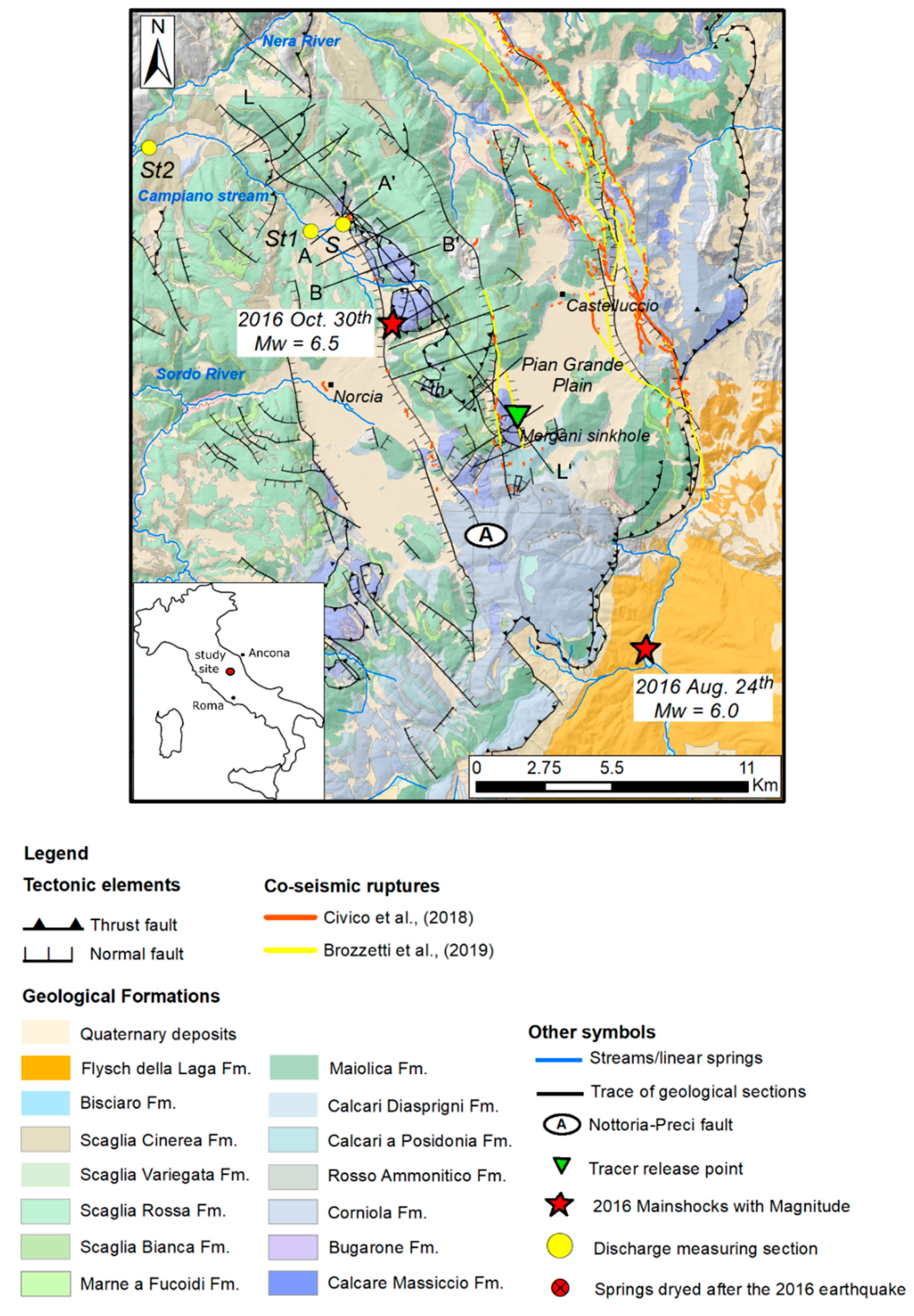
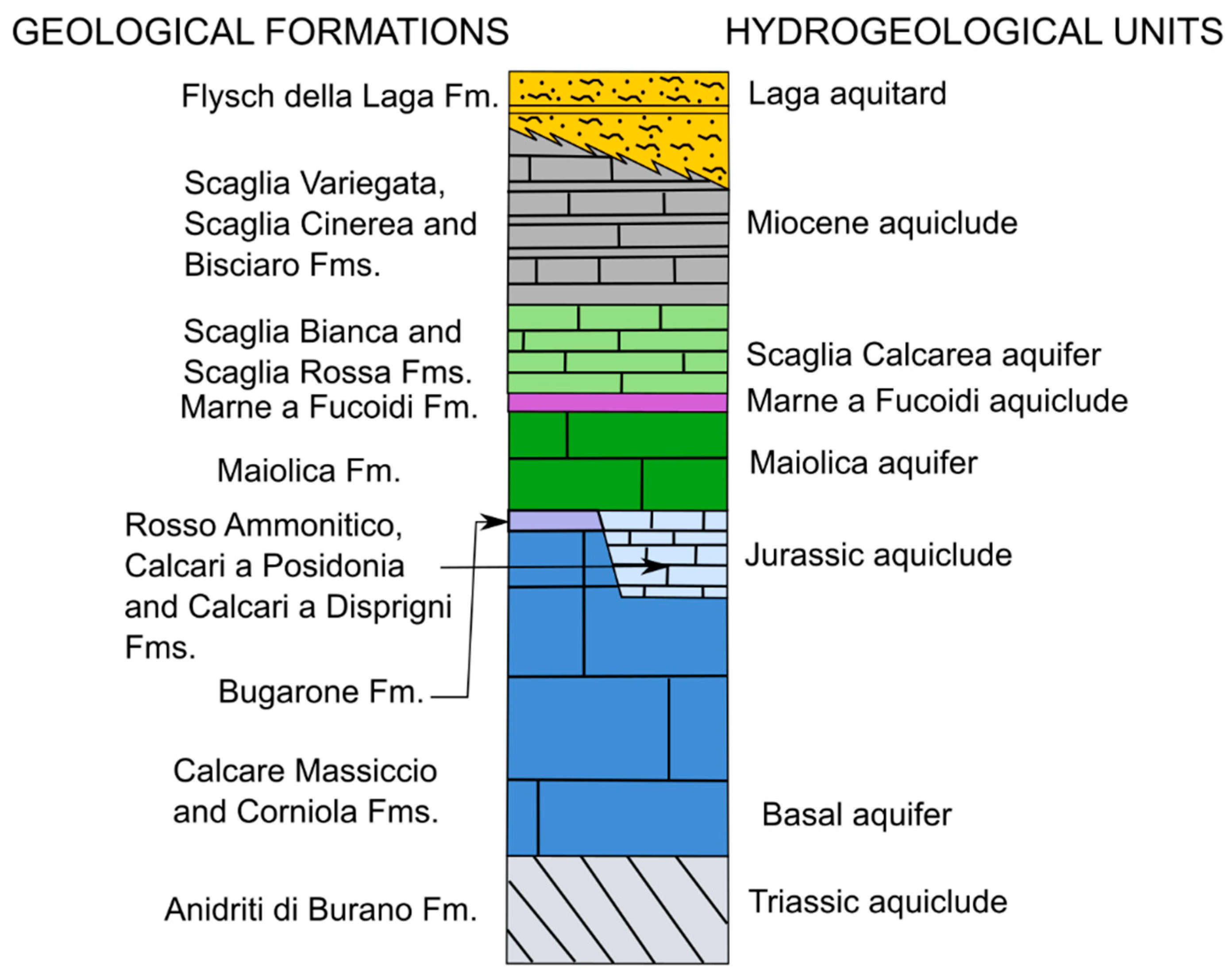
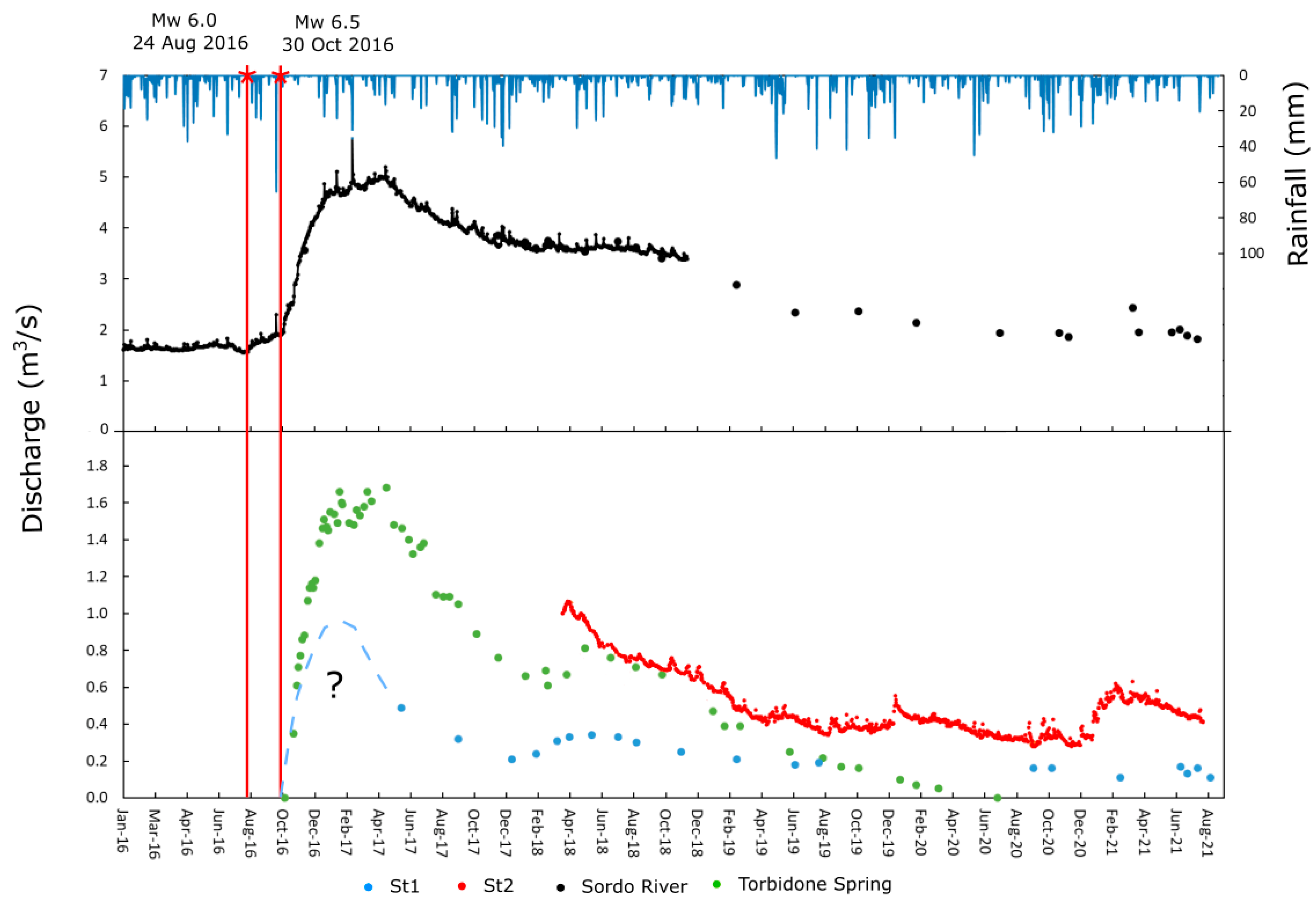
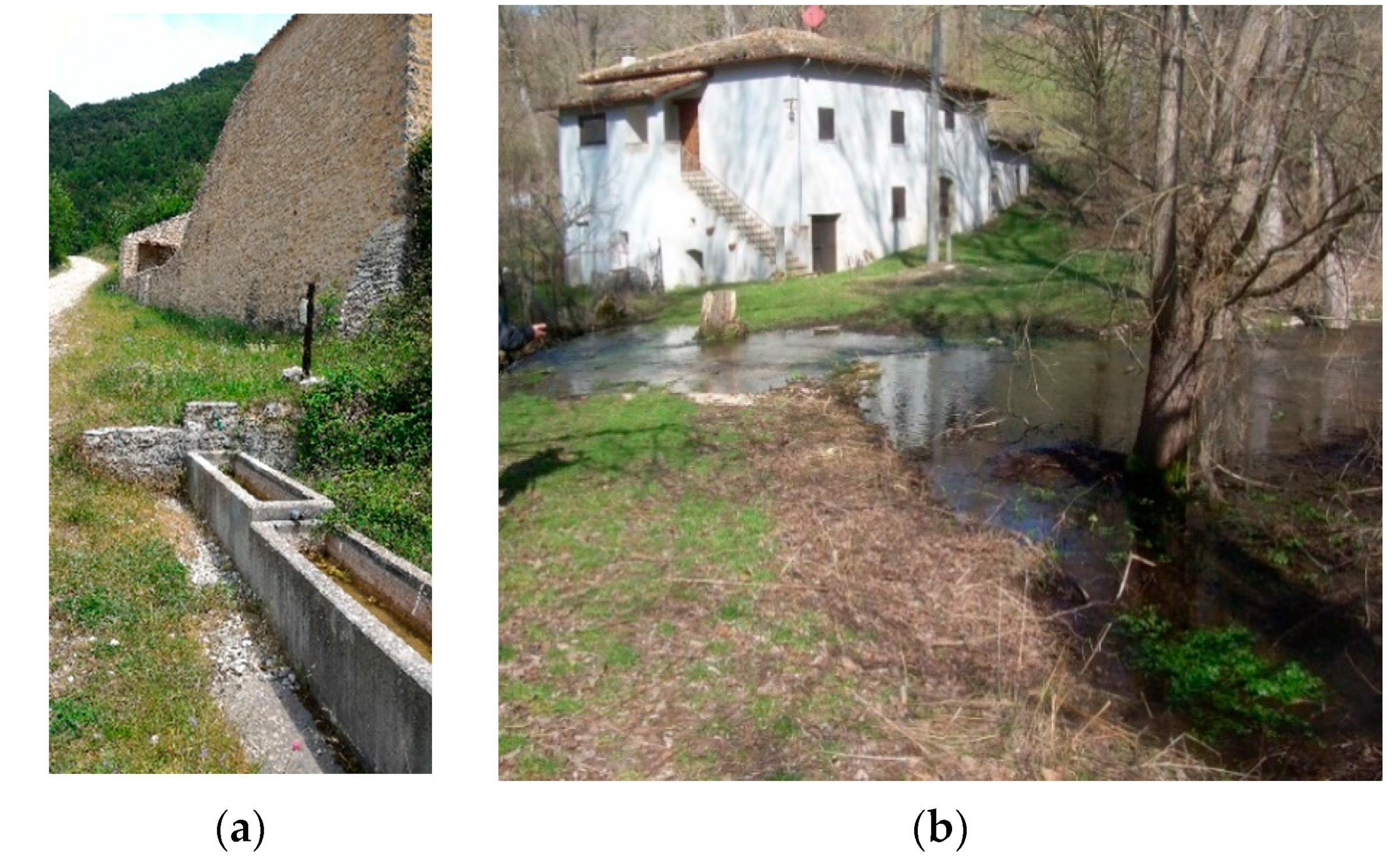
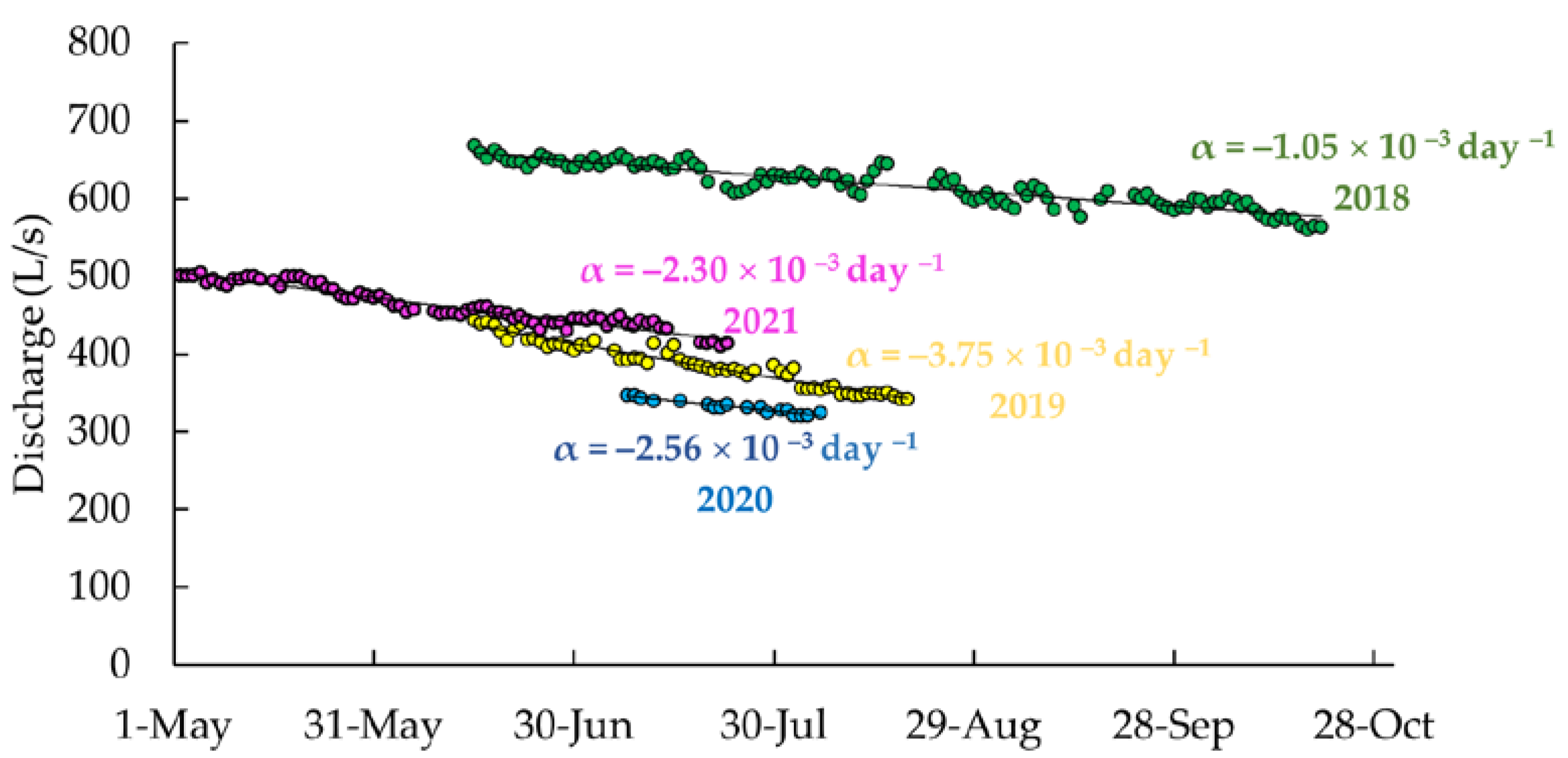
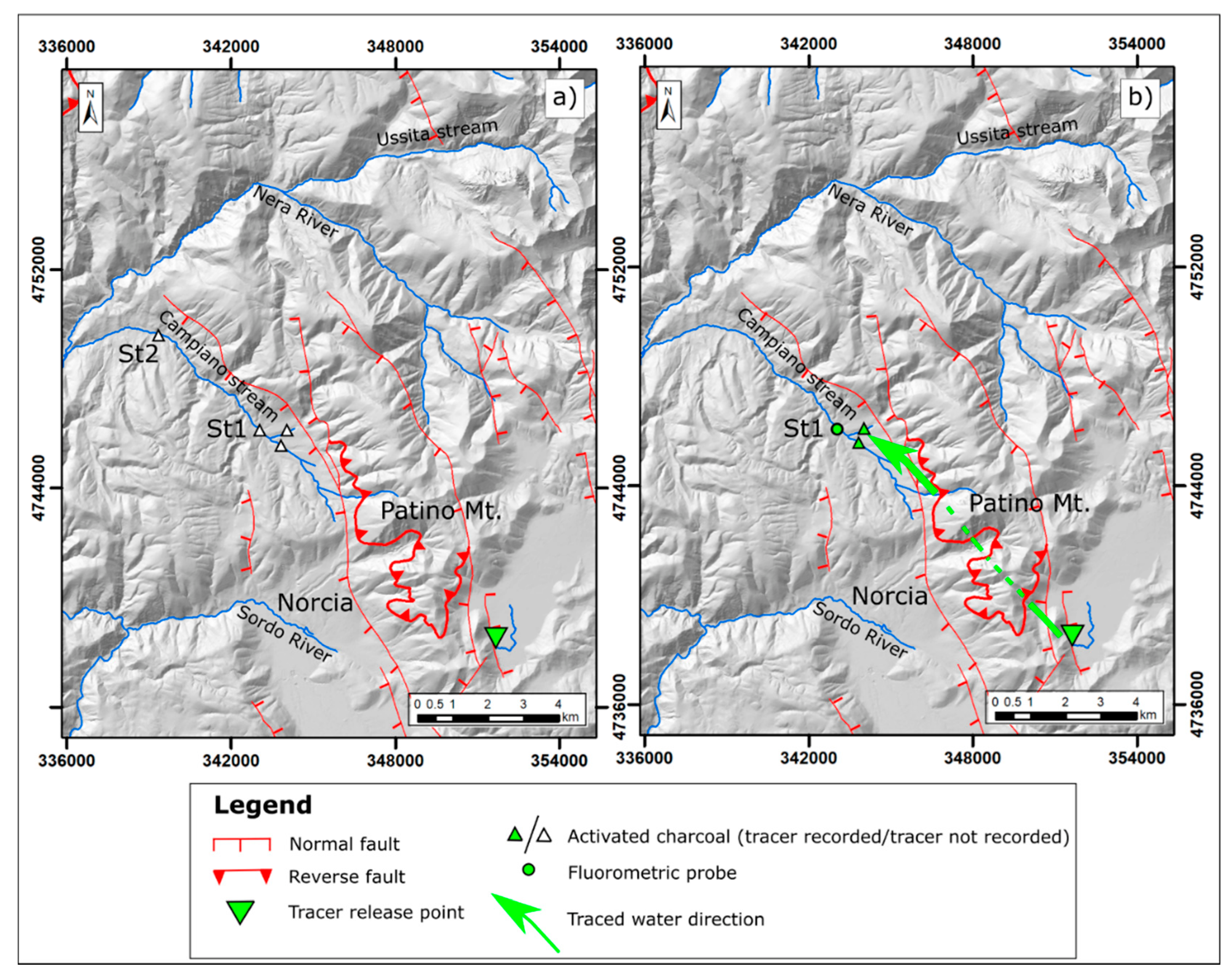
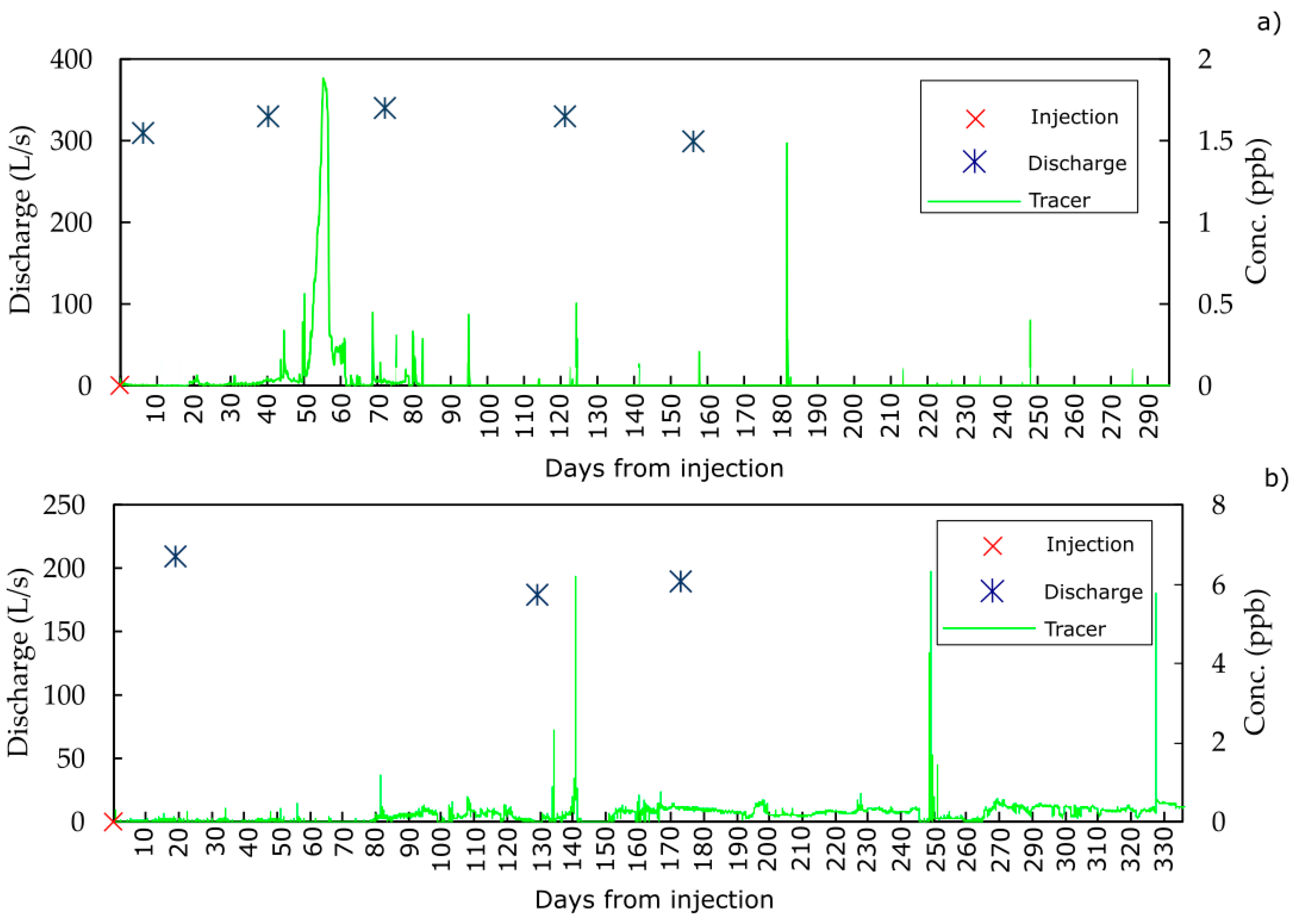

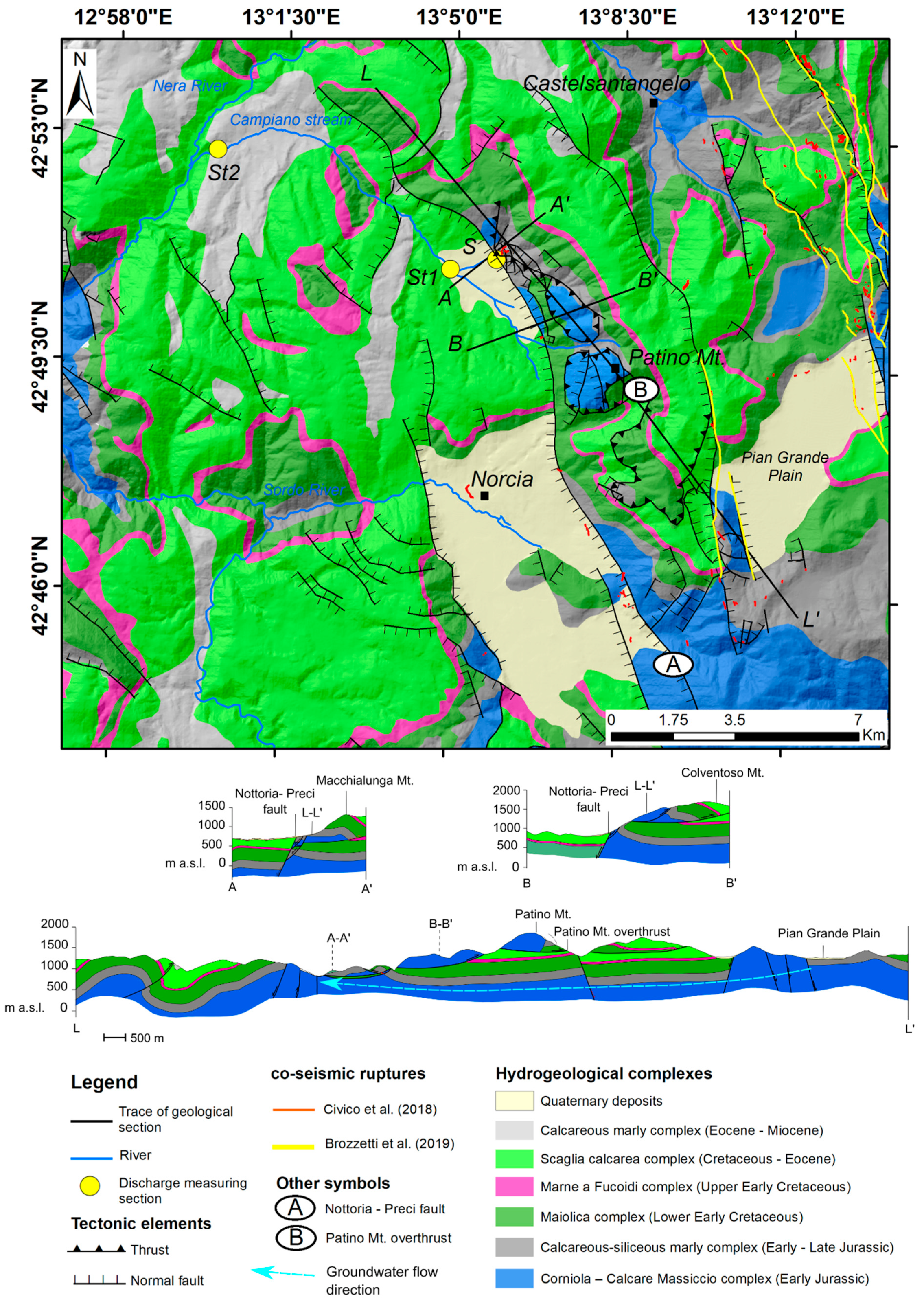
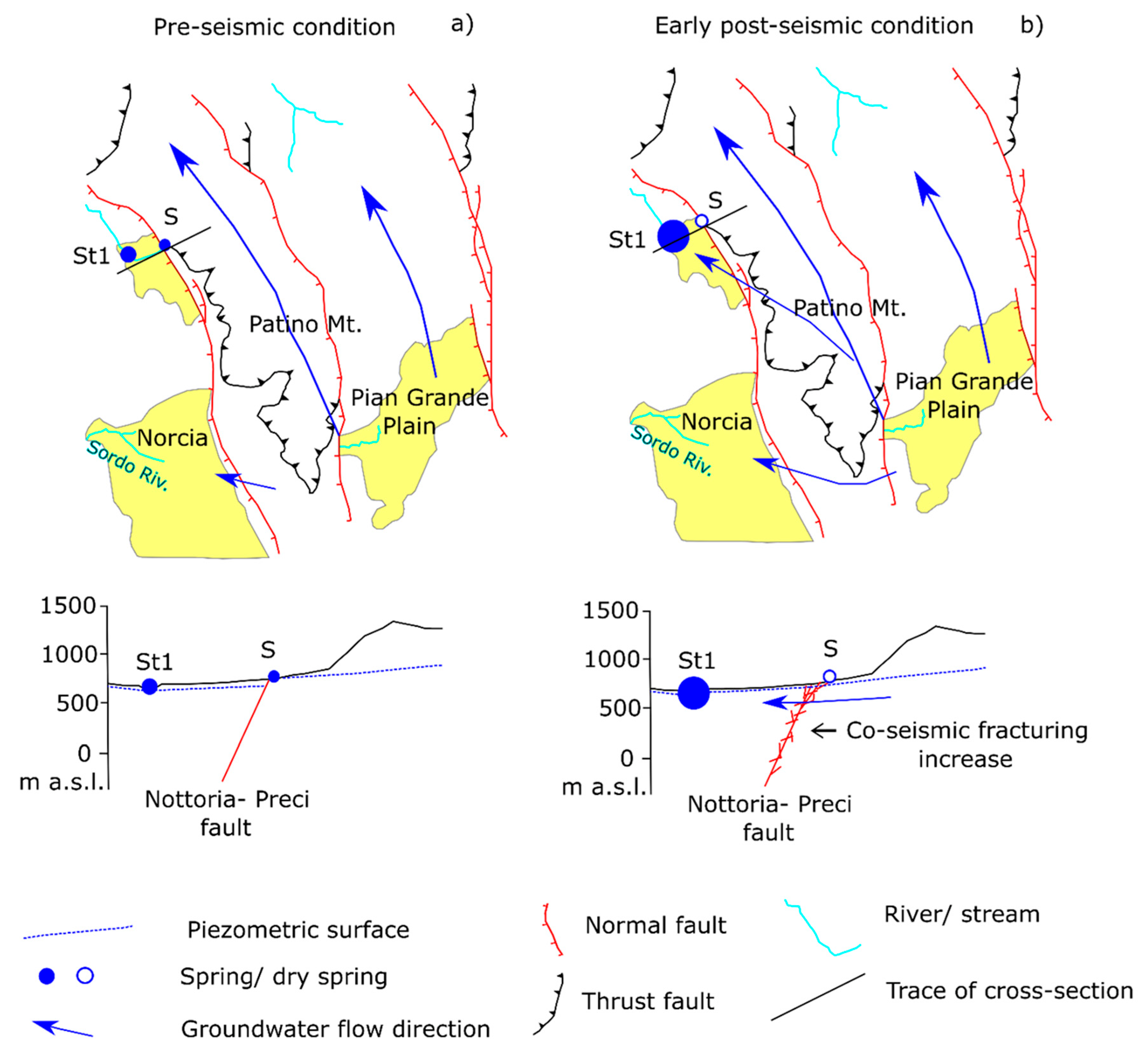
| Discharge Measurement Point | Q Pre-Seismic 2007 (L/s) | Q Post-Seismic 2017–2018 (L/s) | Q Post-Seismic 2019–2021 (L/s) |
|---|---|---|---|
| S | 10 | <0.1 | <0.1 |
| St1 | - | 290 | 160 |
| St2 | - | 770 | 330 |
| SP | Date (dd/mm/yyyy) | T (°C) | pH | EC (μS/cm) | Ca2+ (mg/L) | Mg2+ (mg/L) | Na+ (mg/L) | K+ (mg/L) | HCO3− (mg/L) | Cl− (mg/L) | SO42− (mg/L) | δ18O (‰ vs SMOW) |
|---|---|---|---|---|---|---|---|---|---|---|---|---|
| S | 20/06/2017 | 11.1 | 7.54 | 280 | 56.2 | 0.79 | 2.23 | 0.57 | 180.6 | 3.20 | 0.97 | −9.80 |
| S | 19/07/2017 | 9 | 7.65 | 267 | 53.9 | 0.74 | 1.82 | 0.41 | 174.5 | 3.06 | 0.92 | −10.03 |
| S | 21/09/2017 | 8.9 | 7.72 | 272 | 53.9 | 0.77 | 1.71 | 0.25 | 166.5 | 3.29 | 1.15 | −9.92 |
| S | 20/07/2018 | 9.3 | 7.80 | 282 | 55.0 | 0.89 | 1.82 | 0.24 | 186.4 | 3.39 | 1.51 | −9.56 |
| S | 26/06/2019 | 11.8 | 8.57 | 277 | 54.3 | 0.72 | 1.44 | 0.48 | 170.2 | 3.07 | 1.14 | −9.97 |
| S | 30/06/2021 | 9.4 | 7.91 | 298 | 63.0 | 1.10 | 1.90 | 0.52 | 193.0 | 3.10 | 1.20 | −9.92 |
| Mean (post-seismic) | 9.9 | 7.87 | 279 | 56.1 | 0.84 | 1.82 | 0.41 | 178.5 | 3.19 | 1.15 | −9.87 | |
| St1 | 08/03/2016 | n.a. | n.a. | n.a. | 59.3 | 0.78 | 1.52 | 0.41 | 181.8 | 3.28 | 1.27 | n.a. |
| St1 | 18/03/2016 | 8.5 | 7.52 | 291 | 58.5 | 0.71 | 1.52 | 0.43 | 182.0 | 3.56 | 1.21 | n.a. |
| St1 | 29/03/2016 | n.a. | 7.63 | n.a. | 59.7 | 0.80 | 1.57 | 0.44 | 181.3 | 3.79 | 1.29 | n.a. |
| St1 | 12/04/2016 | n.a. | 7.26 | n.a. | 59.2 | 0.78 | 1.56 | 0.44 | 182.0 | 3.46 | 1.22 | n.a. |
| Mean (pre-seismic) | 8.5 | 7.47 | 291 | 59.2 | 0.77 | 1.54 | 0.43 | 181.8 | 3.52 | 1.25 | n.a. | |
| St1 | 20/07/2018 | 11.7 | 7.90 | 341 | 62.5 | 2.49 | 2.38 | 1.02 | 205.6 | 4.38 | 7.72 | −9.56 |
| St1 | 26/06/2019 | 13.5 | 8.39 | 346 | 63.1 | 2.46 | 1.98 | 1.07 | 196.4 | 4.12 | 7.29 | −9.78 |
| St1 | 30/06/2021 | 10.2 | 7.63 | 361 | 73.0 | 3.40 | 3.30 | 1.20 | 242.0 | 4.80 | 8.60 | −9.73 |
| Mean (post-seismic) | 11.8 | 7.97 | 349 | 66.2 | 2.78 | 2.55 | 1.10 | 214.7 | 4.43 | 7.87 | −9.69 | |
| St2 | 20/07/2018 | 14.1 | 7.97 | 380 | 70.2 | 2.05 | 5.41 | 1.58 | 233.9 | 10.14 | 5.28 | n.a. |
| St2 | 26/06/2019 | 10.9 | 8.56 | 358 | 67.4 | 2.02 | 3.14 | 3.19 | 209.5 | 8.39 | 4.85 | n.a. |
| St2 | 30/06/2021 | 12.4 | 7.95 | 410 | 82.0 | 2.90 | 8.90 | 1.50 | 280.0 | 7.20 | 6.10 | n.a. |
| Mean (post-seismic) | 12.47 | 8.16 | 382.67 | 73.20 | 2.32 | 5.82 | 2.09 | 241.13 | 8.58 | 5.41 | n.a |
Publisher’s Note: MDPI stays neutral with regard to jurisdictional claims in published maps and institutional affiliations. |
© 2022 by the authors. Licensee MDPI, Basel, Switzerland. This article is an open access article distributed under the terms and conditions of the Creative Commons Attribution (CC BY) license (https://creativecommons.org/licenses/by/4.0/).
Share and Cite
Mammoliti, E.; Fronzi, D.; Cambi, C.; Mirabella, F.; Cardellini, C.; Patacchiola, E.; Tazioli, A.; Caliro, S.; Valigi, D. A Holistic Approach to Study Groundwater-Surface Water Modifications Induced by Strong Earthquakes: The Case of Campiano Catchment (Central Italy). Hydrology 2022, 9, 97. https://doi.org/10.3390/hydrology9060097
Mammoliti E, Fronzi D, Cambi C, Mirabella F, Cardellini C, Patacchiola E, Tazioli A, Caliro S, Valigi D. A Holistic Approach to Study Groundwater-Surface Water Modifications Induced by Strong Earthquakes: The Case of Campiano Catchment (Central Italy). Hydrology. 2022; 9(6):97. https://doi.org/10.3390/hydrology9060097
Chicago/Turabian StyleMammoliti, Elisa, Davide Fronzi, Costanza Cambi, Francesco Mirabella, Carlo Cardellini, Emiliano Patacchiola, Alberto Tazioli, Stefano Caliro, and Daniela Valigi. 2022. "A Holistic Approach to Study Groundwater-Surface Water Modifications Induced by Strong Earthquakes: The Case of Campiano Catchment (Central Italy)" Hydrology 9, no. 6: 97. https://doi.org/10.3390/hydrology9060097
APA StyleMammoliti, E., Fronzi, D., Cambi, C., Mirabella, F., Cardellini, C., Patacchiola, E., Tazioli, A., Caliro, S., & Valigi, D. (2022). A Holistic Approach to Study Groundwater-Surface Water Modifications Induced by Strong Earthquakes: The Case of Campiano Catchment (Central Italy). Hydrology, 9(6), 97. https://doi.org/10.3390/hydrology9060097











